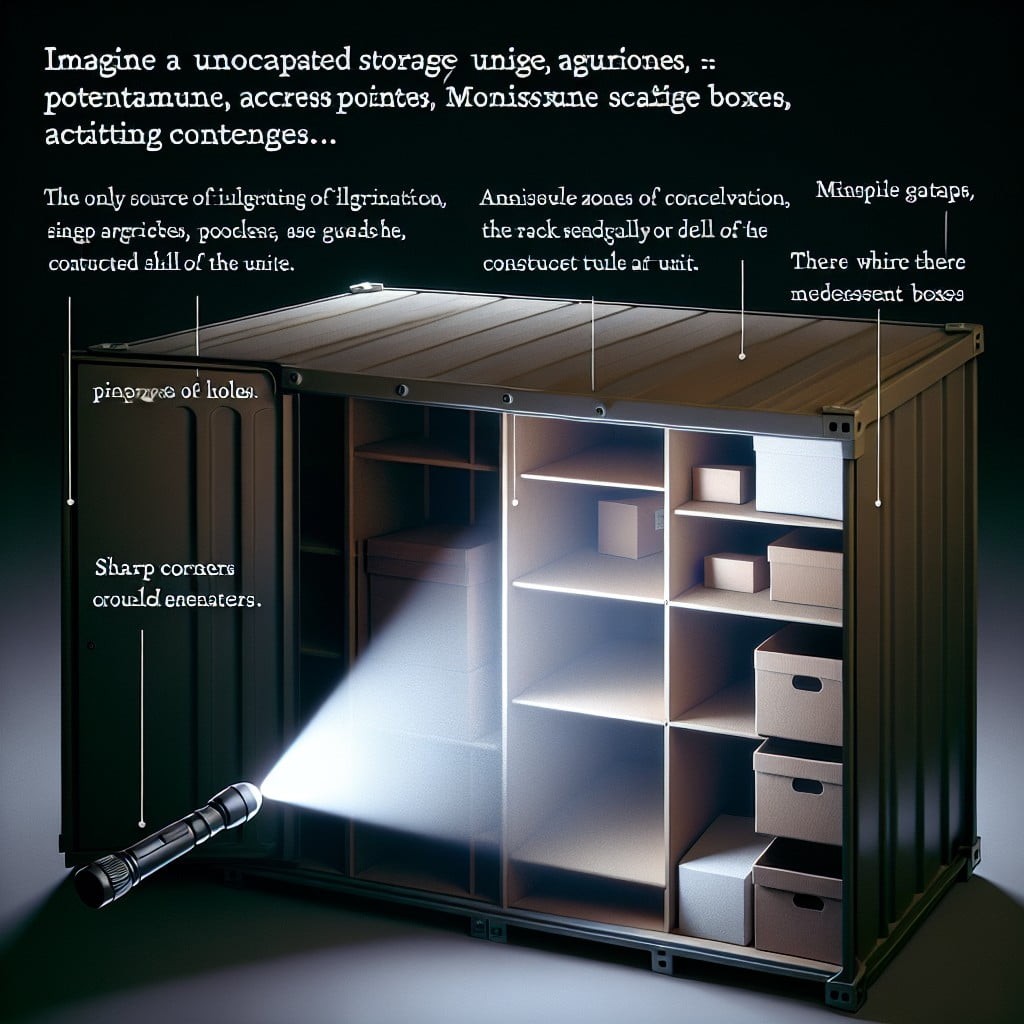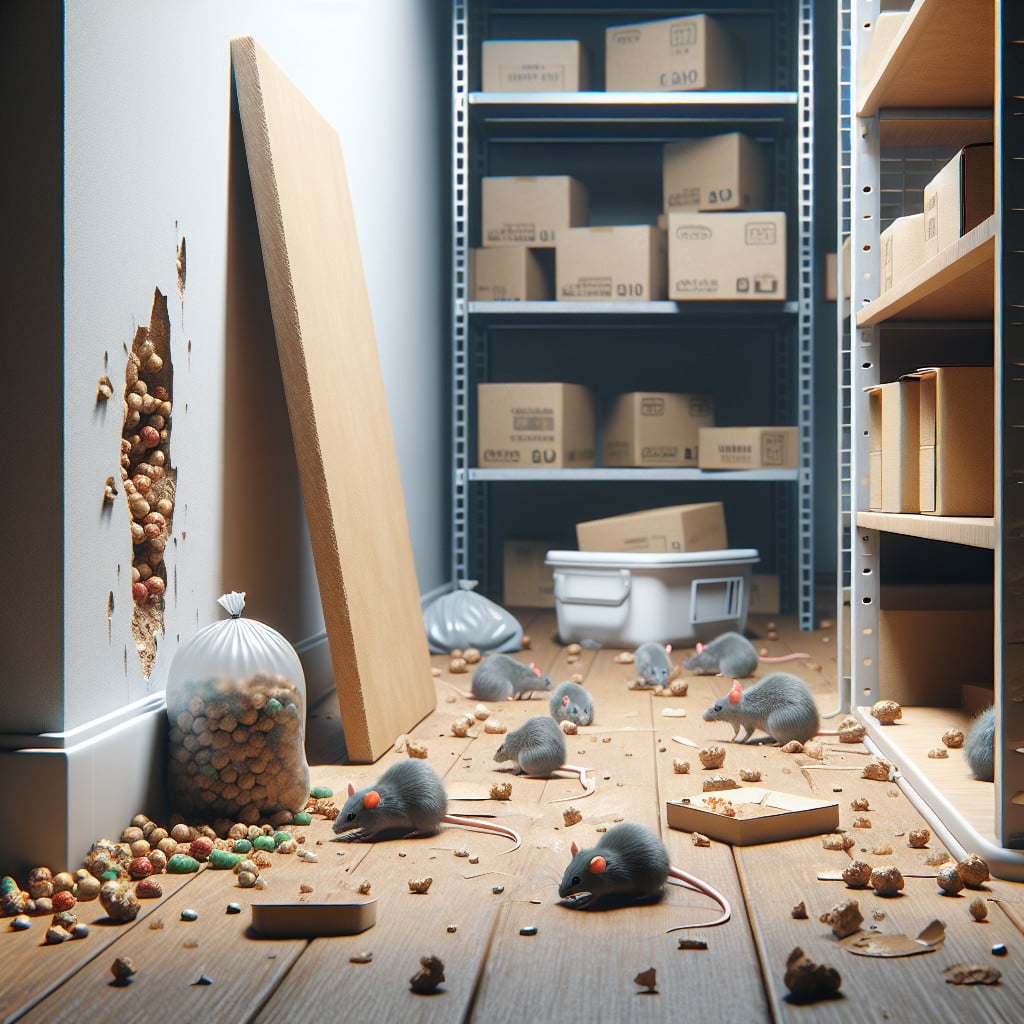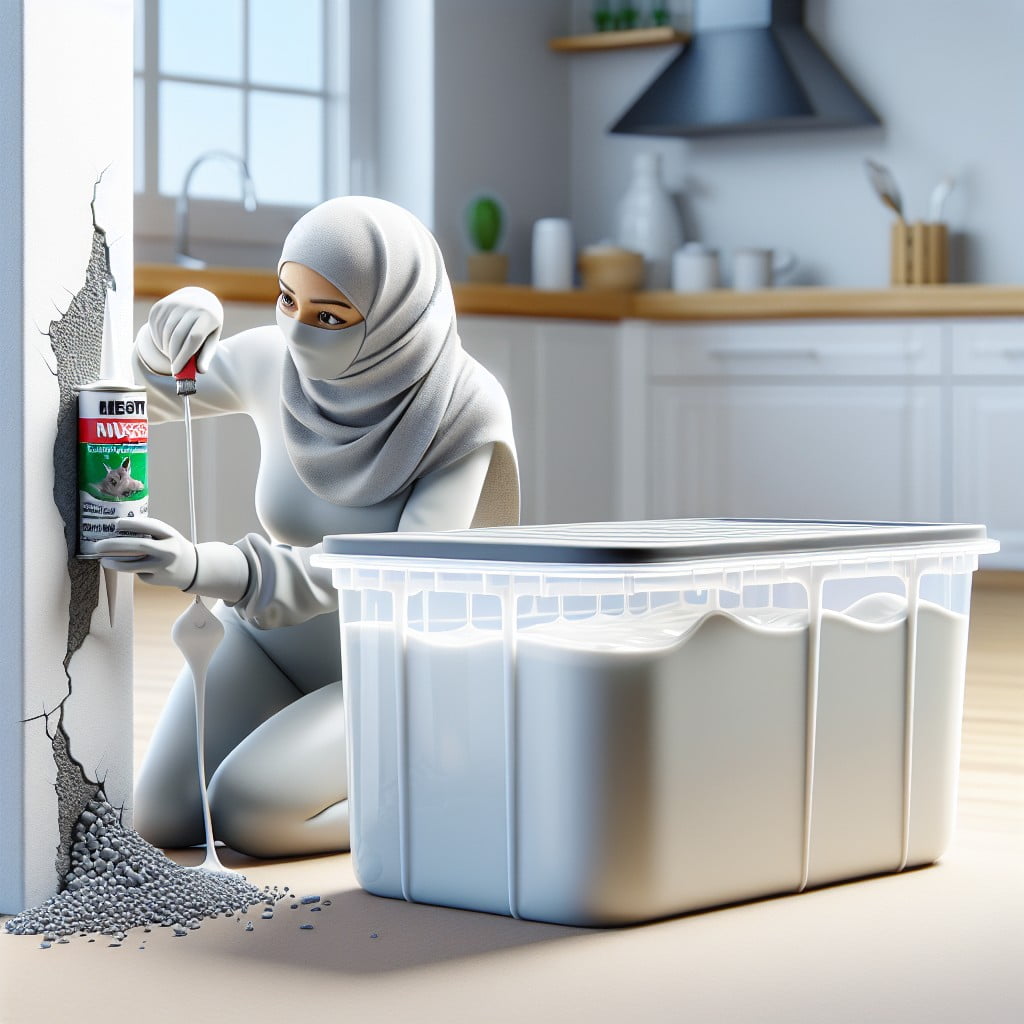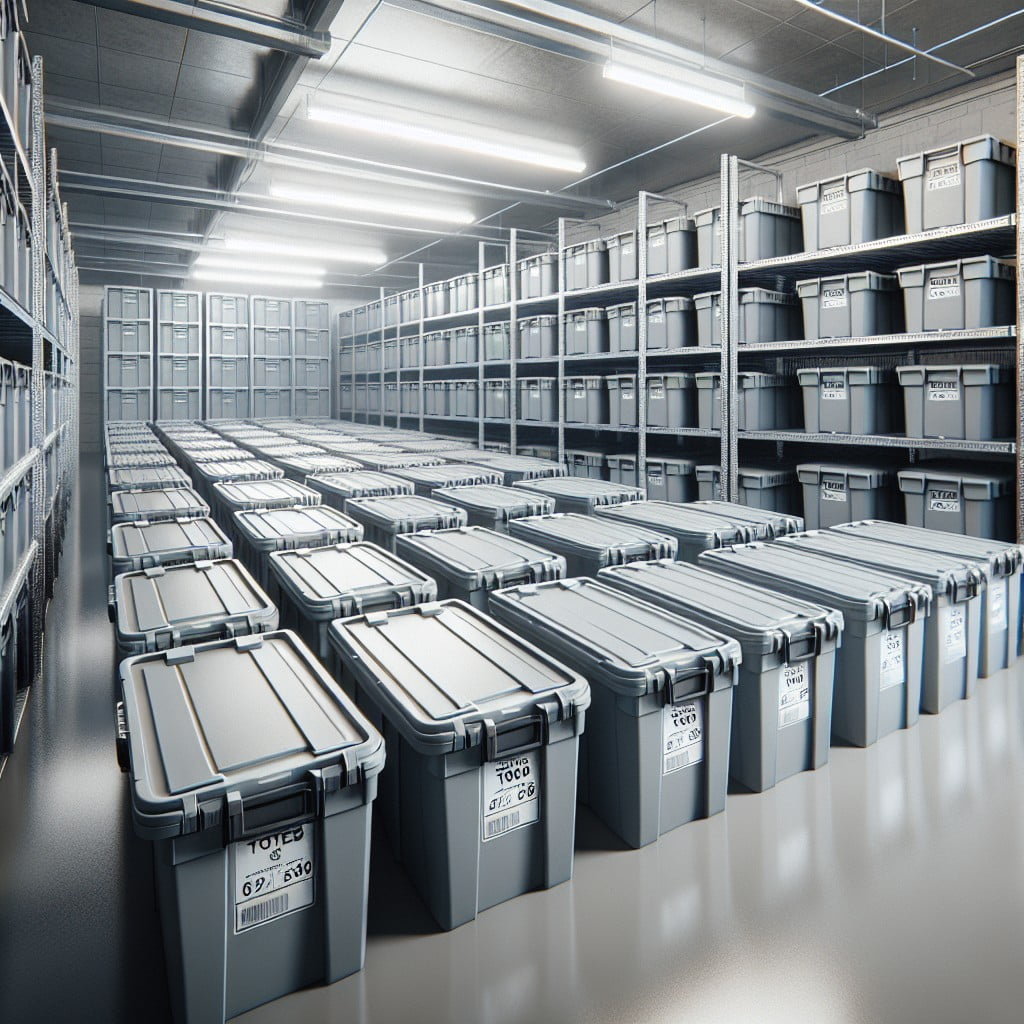Last updated on
Ensuring your storage is mouse-proof is essential because these small rodents can wreak havoc, causing extensive damage to your valuables.
Key takeaways:
- Inspect storage unit for signs of mice
- Look for evidence of mice: droppings, gnaw marks, nests
- Identify and seal potential entry points
- Use heavy-duty plastic storage totes with lids
- Elevate belongings and wrap upholstered furniture in plastic
Inspect Your Storage Unit for Mice

Commence your mouse-proofing efforts by thoroughly examining the unit for signs of rodent presence. Look for droppings, gnawed items, or nests composed of shredded material, as these are telltale indications of mice. Pay close attention to corners and crevices where pests might lurk unseen.
Additionally, scrutinize the walls and flooring for cracks or holes that might serve as entry points for these unwelcome guests. Small openings can be larger than they appear since mice can squeeze through gaps as tiny as a dime. Document any issues and address them promptly to ensure that your items remain safeguarded.
Look for Any Evidence of Mice

Detecting signs of rodent presence is crucial in preventing an infestation. Be on the lookout for:
- Droppings: Small, dark pellets, typically found along walls or in corners.
- Gnaw marks: Check for bite marks on items, particularly wires, insulation, or cardboard.
- Nests: Mice use shredded paper or fabric to create hidden nests.
- Grease marks: Mice can leave greasy smudge marks from their fur as they travel along walls.
- Strange noises: Listen for scratching or rustling, especially at night.
Regular checks for these indicators can help you address a mouse problem before it escalates.
Identify and Seal Potential Entry Points

Mice can squeeze through gaps as small as a dime, making thorough inspection crucial to mouse-proofing your storage.
Examine walls for cracks and holes, especially where utilities enter.
Check windows and doors for gaps; these are common entry points.
Seal cracks with caulk for small openings and expandable foam for larger spaces.
For added protection, cover holes with metal flashing; mice can’t chew through this material.
Ensure all vents are covered with a fine wire mesh to prevent entry without obstructing airflow.
Regularly re-inspect seals for wear and tear to maintain a mouse-proof environment.
Use Heavy-duty Plastic Storage Totes With Lids

Opting for heavy-duty plastic totes instead of cardboard boxes is a key strategy in fortifying your items against rodents.
These containers offer a formidable barrier, thanks to their sturdy construction that withstands gnawing.
Ensure each tote has a secure-fitting lid to prevent mice from gaining access.
Such lids often snap tightly in place, creating a seal that deters entry.
Additionally, transparent totes allow for easy identification of contents without having to open them, reducing the frequency of exposure to potential mice.
For extra peace of mind, consider adding a layer of tape around the edge where the lid meets the tote to fortify the seal.
Remember, the investment in quality storage solutions pays off by protecting your valuables from damage and contamination.
Use a Mouse-proof Mattress Storage Bag
When safeguarding your mattress, consider investing in a specialized storage bag designed to repel rodents. These durable encasements are typically made from thick, rip-resistant materials that stand up to the gnawing and clawing behaviors of mice.
Ensure the bag has a secure closure—zippers are more effective than adhesive seals—to create an airtight barrier that prevents mice from nesting within the fibers of your mattress.
Additionally, select a bag that’s waterproof to protect against moisture, which could attract pests and lead to mold.
For extra peace of mind, frequently check the integrity of the bag for any signs of wear or potential breaches.
Keep Belongings Off the Ground
Elevating items on sturdy shelving units or pallets ensures a gap between your possessions and the floor, reducing the risk of them becoming nesting grounds or access points for mice.
Plastic or metal stands are preferable, as these materials are less appealing to rodents compared to wood.
Consider metal rack shelving or plastic risers designed for storage use—these can support weight while minimizing hiding spots for pests.
Always maintain a clean space beneath shelves to monitor for any signs of mouse activity effectively.
Wrap Upholstered Furniture in Plastic
Upholstered items offer cozy nesting spaces for mice due to their soft materials.
Encasing these items in plastic serves as an effective deterrent.
Ensure that wraps are tight-fitting with no openings, as even small gaps can be an invitation for pests.
Heavy-duty plastic is ideal — it’s less likely to tear if brushed against sharp edges or corners.
Additionally, the plastic barrier prevents mice from detecting the scent of the materials within, further discouraging their interest.
For long-term storage, check the condition of the plastic occasionally to ensure it remains intact.
Remove Cardboard and Paper Items From Storage
Mice are drawn to cardboard and paper for both nesting materials and as a food source. These items can easily become nesting hotspots, complicating your pest control efforts. Instead, opt for durable plastic bins as they offer a sturdier barrier. It’s essential to transfer important documents into plastic file boxes and consider digitizing paperwork when possible to reduce clutter. Similarly, books and other paper goods should be stored in plastic containers with tight-fitting lids to keep mice at bay. By eliminating these mouse-friendly materials, you reduce the risk of infestation and safeguard your belongings.
Avoid Storing Food in Your Unit
Keeping edible items out of your storage space is paramount in deterring rodents. Mice have an acute sense of smell, making any type of food an irresistible lure. Even non-perishables or items with a long shelf life can attract these pests.
To minimize the risk of infestation, consider donating unused food to local shelters or securely store it in a mouse-proof pantry at home. It’s also important to empty and clean appliances such as refrigerators or stoves before placing them in storage, as residual crumbs or spills can be an unexpected food source.
Remember, prevention is key—by not providing a food supply, you significantly reduce the likelihood of mice making a home amongst your possessions.
Fill Holes With Steel Wool
Mice can squeeze through surprisingly small openings, seeking out even the tiniest of gaps to invade storage areas. To prevent their entry, locate any holes or cracks and firmly pack them with steel wool. This material is an effective barrier because its sharp fibers deter mice, who are unable to chew through the tough texture.
For added security, consider applying caulk around the steel wool to seal the holes completely. This step is crucial in bolstering the defenses of your storage space against these persistent pests. Remember, diligence in sealing openings not only helps with mouse proofing but also minimizes the risk of other critters gaining access.
Use Peppermint Oil Around Your Unit
Peppermint oil acts as a natural deterrent due to its strong scent, which mice find overwhelming.
Here’s how to apply it effectively:
1. Saturate cotton balls with oil and strategically place them near potential entry points and corners, as mice tend to follow walls.
2. Refresh these cotton balls every few weeks to ensure the scent remains potent and continues to ward off any curious rodents.
3. Consider dabbing a few drops directly on surfaces that aren’t prone to oil staining for an additional barrier.
4. Mix peppermint oil with water in a spray bottle and apply the mixture around the perimeter of your storage unit for a wider-ranging repellent effect.
Remember, this method is complementary and works best in conjunction with other preventative measures.
Set Mouse Traps
Ensuring that traps are correctly placed is crucial for effective mouse deterrence. Position snap traps along walls where mice typically travel, with the bait and trigger side facing inward.
Live-catch traps should also be situated in similar locations but check them regularly to release any caught mice far from your unit.
When using bait, opt for peanut butter or chocolate, which are highly attractive to mice.
Avoid handling the traps with bare hands, as the human scent can deter mice from approaching.
For a more humane approach, consider electronic traps, which deliver a quick, high-voltage shock.
Be sure to check and clear traps frequently to maintain their effectiveness and avoid health hazards associated with decaying rodents.
Contact Management for Extermination
When you suspect a mouse infestation, immediately inform the facility management. They are typically responsible for pest control and will arrange for professional extermination services.
It’s vital to report promptly, as mice reproduce quickly and can cause more damage and contamination over time. Provide details on sightings or evidence of mice to help the exterminators focus their efforts.
Regular extermination schedules may be in place; ask the management so you can prepare your storage unit ahead of these visits.
Maintain open communication with the facility to stay updated on any pest control measures and to contribute to a mouse-free environment.
Regularly Clean and Inspect Your Unit
Maintaining a consistent cleaning schedule is pivotal in deterring mice. By doing so, you reduce the chance of nesting materials and food crumbs, which can attract these pests. When tidying up:
- Sweep and vacuum the floors to eliminate any particles that may have been missed during previous clean-ups.
- Wipe down surfaces, especially along the baseboards and corners where mice may travel.
- Dispose of trash and any clutter that could provide hiding spots for mice.
During inspections, pay close attention to:
- Signs of droppings, gnaw marks, or nesting materials, as these are indicators of mouse activity.
- Cracks or holes, no matter how small, through which mice could potentially enter.
- The condition of stored items, identifying any that may have been compromised and require more secure packaging.
By keeping your storage unit clean and performing regular checks, you vastly improve its mouse-proofing effectiveness.
Choose the Right Unit for You Today!
Selecting an appropriate unit plays a crucial role in keeping mice at bay. Prioritize facilities that prioritize cleanliness and pest control measures in their operations.
Units constructed with solid materials, as opposed to those with gaps or flimsy walls, can deter mice more effectively. Climate-controlled units can also reduce the likelihood of a mouse infestation since they provide a less hospitable environment for rodents.
Carefully research and consider the maintenance and security protocols of the storage facility before making your decision. Additionally, opt for a unit that offers enough space to store your items off the ground, which can further protect against pests.
If you have any specific concerns, don’t hesitate to discuss them with the facility management to ensure that your belongings will be safeguarded. Remember, a well-chosen storage unit is not only a place to keep your items but also a shield against unwelcome rodents.
FAQ
What is the best storage to keep mice out of?
The optimal storage to deter mice infestation comprises of sturdy, airtight containers, as flimsy materials like paper, cardboard, or thinly-made plastic containers are prone to mouse-driven destruction.
What containers can mice not chew through?
Mice are incapable of chewing through plastic storage containers.
How do I keep mice out of my storage unit?
To deter mice from entering your storage unit, apply several drops of peppermint oil on a cotton ball and position it near potential entry points such as holes or cracks.
How do you mouse-proof a storage bin?
You can mouse-proof a storage bin by utilizing plastic containers with airtight lids instead of cardboard boxes, which not only wards off mice and other pests but also provides convenience in carrying and stacking.
What are effective repellents to deter mice in storage areas?
Effective mouse repellents for storage areas include ultrasonic devices, peppermint oil, and commercially sold rodent repellents.
How often should preventative measures be taken to ensure a mouse-free storage unit?
Preventative measures should be implemented monthly to ensure a mouse-free storage unit.
Can specific arrangements of items in a storage unit deter mice?
Yes, specific arrangements of items in a storage unit, especially those involving sealing foodstuffs and removing clutter, can deter mice.
Recap:




